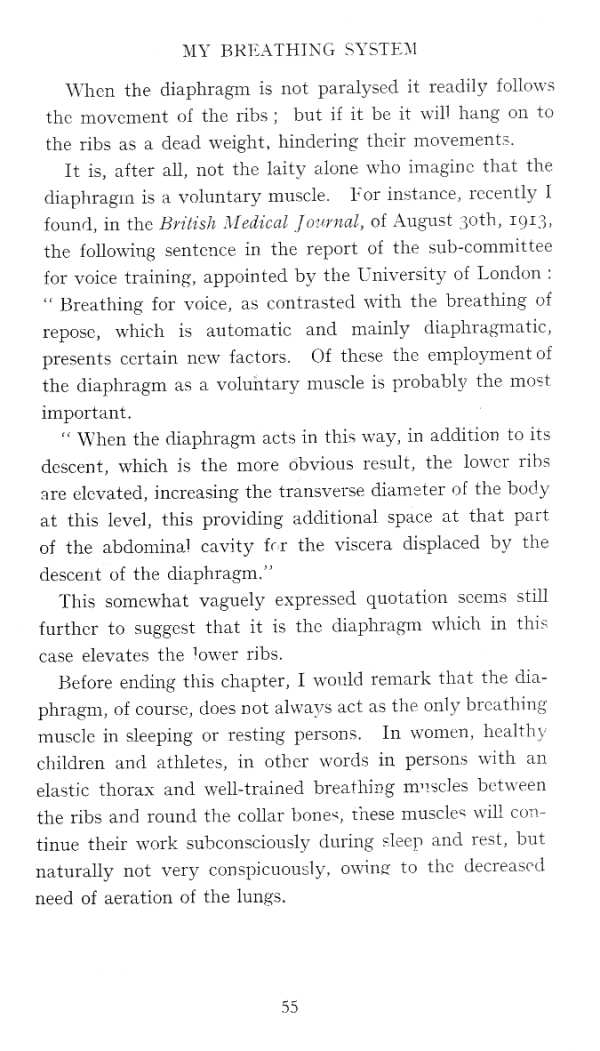mbs 055

MY BREATHING SYSTEM
Whcn the diaphragm is not paralysed it readily follows thc movcment of the ribs ; but if it be it will hang on to the ribs as a dead weight. hindcring thcir movements.
It is, after all, not the laity alone wlio imaginc that the diaphragm is a yoluntary muscle. l;or instance, rccently I found, in thc Brilisli Medical Journal, of August toth, 1913, the lollowing sentcnce in the report of the sub-committee for voice training, appointed by the University of London : “ Breathing for voice, as contrasted with the breatlring of reposc, which is automatic and mainly diaphragmatic, presents ccrtain ncw factors. Of these thc empłoyment of the diaphragm as a voluntary muscle is probably the most important.
“ When the diaphragm acts in this way, in addition to its descent, which is the morę obvious result, the lowcr ribs are elcvated, incrcasing the transverse diameter of the body at this level, this providing additional space at that part of the abdomina! cavity frr the viscera displaced by the descent of the diaphragm.”
This somewhat vaguely expressed ąuotation sccms still furthcr to suggest that it is the diaphragm which in this case elevates the 'ower ribs.
Before ending this chapter, I would remark that the diaphragm, of coursc, does not always act as the only breathing muscle in sleeping or resting persons. In women, healthy cliildren and athletes, in othcr words in persons with an elastic thorax and well-trained breathing moscJes between the ribs and round the collar bones these muscle* will con-tinue their work subconsciously during sleep and rest, but naturally not very conspicuously, owi ner to thc decreascd need of aeration of the lungs.
55
Wyszukiwarka
Podobne podstrony:
mbs 022 MY BREATHING SYSTEM against the invasion and throw ol f thc gernis, which arc ejected with t
mbs 027 MY BREATHING SYSTEM sucked in. For persons who lind it very difficult to acquire tłiis contr
69745 mbs 028 MY BREATHING SYSTEM When the mucous membranc of the nose has become too cold, it is no
43484 mbs 050 MY BREATHING SYSTEM diaphragm which is brought into a nearly vertical position when th
mbs 052 MY BREATHING SYSTEM 1 think there exists a good deal of superstition about the diaphragm, th
mbs 014 MY BREATHING SYSTEM slow, regular respiration, even during the hardcst and most protracted e
mbs 035 MY BREATHING SYSTEM How to Expand and Contract the Thorax to its fullest Extent The thoracic
mbs 040 MY BREATHING SYSTEM expansiou alone gives tlić best result, others, Jikt* the French lieuteu
mbs 042 MY BREATHING SYSTEM the liarm done by such old habits that special excrcise of “ abdominal&q
więcej podobnych podstron